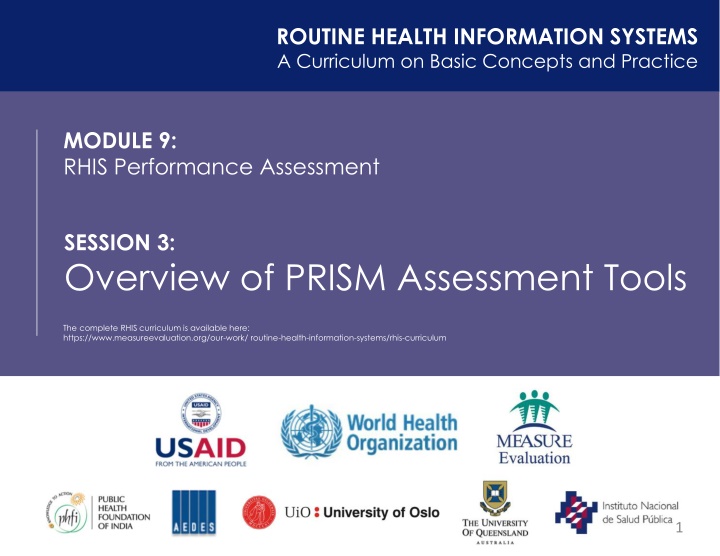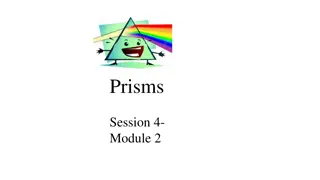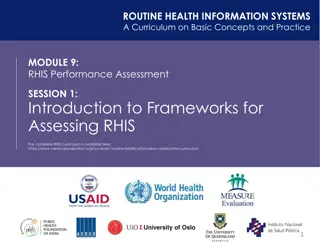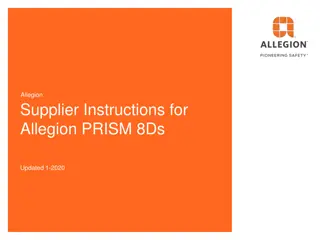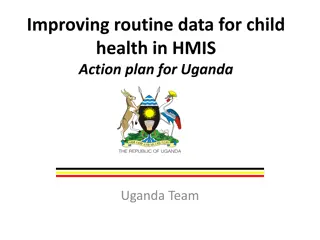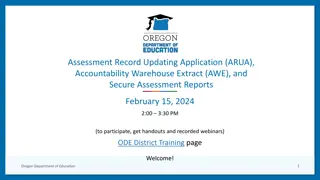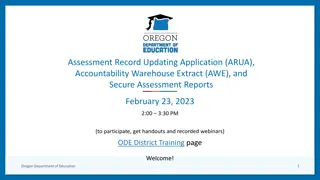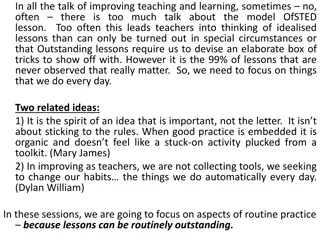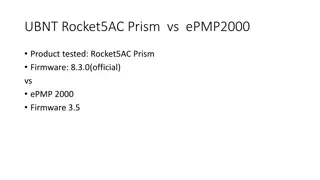Overview of PRISM Assessment Tools in Routine Health Information Systems
This module provides a comprehensive overview of the PRISM assessment tools used for evaluating and improving the performance of Routine Health Information Systems (RHIS). The PRISM tool set includes six tools designed to establish performance baselines, identify influencing factors, prioritize interventions, and advocate for support. Participants will learn how to apply these tools effectively to diagnose RHIS performance and its determinants. The curriculum covers topics such as data quality, information use, technical and behavioral factors, and organizational aspects that impact RHIS performance.
Download Presentation

Please find below an Image/Link to download the presentation.
The content on the website is provided AS IS for your information and personal use only. It may not be sold, licensed, or shared on other websites without obtaining consent from the author.If you encounter any issues during the download, it is possible that the publisher has removed the file from their server.
You are allowed to download the files provided on this website for personal or commercial use, subject to the condition that they are used lawfully. All files are the property of their respective owners.
The content on the website is provided AS IS for your information and personal use only. It may not be sold, licensed, or shared on other websites without obtaining consent from the author.
E N D
Presentation Transcript
ROUTINE HEALTH INFORMATION SYSTEMS A Curriculum on Basic Concepts and Practice MODULE 9: RHIS Performance Assessment SESSION 3: Overview of PRISM Assessment Tools The complete RHIS curriculum is available here: https://www.measureevaluation.org/our-work/ routine-health-information-systems/rhis-curriculum 1
Learning Objectives Objectives Participants will be able to: Describe how the set of PRISM tools is organized Explain the purpose of each tool Understand application of PRISM tools to diagnose RHIS performance and its determinants 2
Topics Covered Topics Covered Overview of PRISM tools to assess and improve RHIS performance RHIS assessment process 3
The PRISM Tool Set Purposes of PRISM s 6 tools: Establish a baseline for performance of an RHIS and monitor progress Identify technical, behavioral, and organizational factors that affect RHIS performance Aid in designing and prioritizing interventions to improve performance Advocate mobilizing technical and financial support to improve RHIS performance 4
PRISM Tool Set: 6 Tools I: Electronic Assessment Tool FUNCTIONALITY USABILITY II- RHIS Performance Diagnostic Tool DATA QUALITY USE OF INFORMATION III- RHIS Overview Tool IV- Facility/ Office Checklist V- RHIS Management Assessment Tool (MAT) VI- Organizational & Behavioral Assessment Tool (OBAT) 5
PRISM Conceptual Framework A Comprehensive Picture of RHIS Performance OUTPUT INPUT PROCESSES OUTCOMES IMPACT RHIS Determinants Diagnostic and Electronic Assessment Tools Technical Factors Complexity of reporting forms, procedures HIS design Computer software Information technology complexity RHIS Performance Diagnostic tools Behavioral Factors Level of knowledge of content of HIS forms Data quality checking skills Problem solving for HIS tasks Competence in HIS tasks Confidence levels for HIS tasks Motivation Improved RHIS Performance Data quality RHIS Processes Data collection Data transmission Data processing Data analysis Data quality check Feedback Improved Health Status Improved Health System Performance Organizational Factors Critical management functions & information needs Governance Planning Training Supervision Quality Finance Information use MAT Overview Tool Promotion of culture of information OBAT Availability of resources Facility/Office Checklist 6
PRISM Tools TOOLS Levels of Application I Electronic RHIS Assessment Tool (Functionality and Usability) Functionality at national level Usability at each level using electronic RHIS Health facility and district or higher levels Mainly at national level, but can be used at subnational levels Health facility and district or higher levels II RHIS Performance Diagnostic Tool (Data Quality & Use of Information) RHIS Overview Tool III IV Facility/Office Checklist V Management Assessment Tool (MAT) District or higher levels VI Organizational and Behavioral Assessment Tool (OBAT) Part 1 at all levels Part II at district and higher levels Parts III and IV at health facility 7
I: Electronic RHIS Assessment Tool Use to assess how well: The electronic RHIS is designed with functions that the system is expected to perform (Functionality) at national level The staff are able to use the system to carry out its functions (Usability) at any level of the system Measures functions as part of the RHIS process and technical factors such as: 1.Unique identifiers for health facility (Master Facility List) 2.Aggregate report generation 3.Coverage calculation using population estimates 4.Data integration (interoperability) 5.Data disaggregation by sex and age 6.Data analysis and visualization 8
II: RHIS Performance Diagnostic Tool Use to: Determine the current level of RHIS performance at Health Facility and District or Higher Levels Regularly monitor RHIS performance Measures: 1. Status of RHIS performance (data quality and information use) 2. RHIS processes 3. Technical determinants 9
II - RHIS Performance Diagnostic Tool Measuring RHIS Performance Data Quality Information Use Accuracy Do data reflect what is actually happening at the facility? Completeness Are all facilities reporting? Are all required data elements reported? Timeliness Are facilities reporting by or before deadline? Health service performance review Revising strategies, developing plans, setting targets Re/defining site personnel responsibilities Mobilization and shifting of resources Advocacy for more resources Display of information 10
II: RHIS Performance Diagnostic Tool Measuring RHIS Process Data collection o Are there manuals to guide data collection? Data transmission o Compilation and reporting of data; reporting timeframe; instruction on timely submission of reports Data quality check o Presence of data quality check mechanisms Data processing and analysis o Data processing procedures; comparisons of data Data presentation Feedback 11
II: RHIS Performance Diagnostic Tool Technical Factors User-friendliness or complexity of reporting forms, procedures HIS design Does the information system design provide a comprehensive picture? Is the information system integrated, or is there duplication of information? Functionality of electronic RHIS Information technology complexity Does the software allow for identifying data quality issues? 12
III: RHIS Overview Tool Use to understand structure of: Existing information systems, type of information collected, and duplication of information Information flows among different levels of the organization Interaction between the different HIS It includes: Data collection and transmission sheet Information system mapping sheet Information flow sheet 13
III: RHIS Overview Tool Data Collection and Transmission Sheet SECTION 1. PAPER-BASED DATA RECORDING TOOLS SECTION 2. ELECTRONIC DATA RECORDING TOOLS (AT FACILITY LEVEL) Name of the Register / Form Name of the Electronic System ICT applications/ software used for data recording (eg. Excel, Access, EMR, DHIS2, GIS, Other) Purpose (type of information recorded) Purpose (Type of information recorded) General OPD services General OPD services In-patient services In-patient services Immunization services Immunization services FP services FP services Maternal health services Maternal health services Child health services Child health services TB TB HIV/AIDS HIV/AIDS . Which organization introduced the register/from Which organization introduced the electronic system MOH (Standardized National HIS Tool) MOH (Program Specific - Name) MOH (Standardized National HIS Tool) MOH (Program Specific - Name) UN Agency (Name) UN Agency (Name) Regional/state government Other partner/donor (Name) Regional/state government Other partner/donor (Name) 14 Local improvised Local improvised Other (specify) Other (specify)
III: RHIS Overview Tool Information Mapping Sheet SECTION 3. INFORMATION MAPPING SHEET Name of the report generated by community / health facility/ district Paper- based or Electronic If electronic, type of electronic system (Excel, Access, DHIS2, GIS; other software) Type of data reported Which organization introduced the report MOH (Standardized National HIS Tool) (Mark P or E) Medicine, vaccines, contraceptive MOH (Program Specific - Name) Other partner/donor (Name) Regional/state government Notifiable diseases (IDSR) Other specific disease(s) Maternal health services General OPD services Immunization services Financial information Child health services UN Agency (Name) In-patient services Nutrition services Human resources Local innovation Other (specify) stock/supply FP services HIV/AIDS Malaria Other TB 15
III: RHIS Overview Tool Example: Information Mapping Sheet 16
III: RHIS Overview Tool Information Flow Sheet SECTION 4. INFORMATION FLOW SHEET Name of the report generated by community/ health facility/ district Paper-based or Electronic If electronic, type of electronic system (Excel, Access, DHIS2, GIS; other software) Report sent to* (Mark P or E) * List the various levels (from bottom to top) where the data is transmitted and received. Also capture if there are interdepartmental data transmission within the same organizational level. Use arrows to indicate the data flow17
III: RHIS Overview Tool Information Flow Mapping 18
IV: Facility/Office Checklist Used to: Understand availability of resources and their conditions at health facilities, district offices and higher levels Identify systemic resource issues at any level of the system It measures availability of: 1.Equipment (computers, printers, backup units, etc.) 2.Utilities (electricity, back-up power, internet, etc.) 3.Registers and forms (RHIS supplies) 4.Human resources 20
V: Management Assessment Tool (MAT) Used to: Measure the level of effectiveness of RHIS key management functions at district or higher levels, such as: 1. RHIS governance 2. RHIS planning 3. Supervision 4. Training 5. Use of quality/performance standards 6. Finance 21
VI: Organizational and Behavioral Assessment Tool (OBAT) This is a self-assessment tool. Uses: Assess whether the organizational mechanisms are in place to produce desired results in RHIS performance Identify the support of upper management for enhancing the RHIS Quantify staff performance in the RHIS Measures: 1. Promotion of information culture 2. Individual behavior 22
VI: Organizational and Behavioral Assessment Tool (OBAT) Who should fill out the tool? OBAT WHO? WHAT? (Sections) PART 1 Staff and management at all levels Respondent background Promotion of information culture RHIS knowledge Perception of competency to perform RHIS tasks Competency to perform RHIS tasks PART 2 Staff and management at district and higher levels PART 3 Health facility in-charge Competency to perform RHIS tasks PART 4 Data management staff in the health facility Competency to perform RHIS tasks 23
VI: Organizational and Behavioral Assessment Tool (OBAT) Promotion of Information Culture Does the organization promote a culture of information? Emphasis on data quality Value for use of information Evidence-informed decision making Problem-solving capacity Promote feedback Sense of responsibility Empowerment and accountability 24
VI: Organizational and Behavioral Assessment Tool (OBAT) Individual Behavior Behavioral assessments: Confidence level for carrying out RHIS tasks Knowledge of the rationale for RHIS and method of data quality checks Skills for data quality assurance, data analysis, interpretation, problem-solving, and use Motivation to perform RHIS tasks 25
Application of PRISM Tools Tools are administered, based on: Observations, interviews, document review, information technology review Triangulation of multiple data sources increases validity of findings Self-assessment aspect creates sense of ownership for results and atmosphere of collaboration 26
Steps to Administer PRISM Tools Identify a potential opportunity o Determine how PRISM tools would be used for the present need Perform pre-assessment planning o Determine organization s readiness to improve RHIS o Assemble core team stakeholders o Identify key informants to interview o Modify PRISM Tool to fit local application o Sampling process Assess and analyze current RHIS performance o Use the tools in order (Overview, Office/Facility Checklist, Diagnostic, Organizational/Behavioral, Management Assessment) Define a plan to reach desired level of RHIS performance Implement the plan and monitor progress 27
Sampling Process Sampling Method Determined by the purpose of the assessment PRISM for evaluation PRISM for monitoring PRISM for ad hoc monitoring or rapid assessment Sampling Unit From a sampling standpoint, the prime target of the PRISM assessment is the facility. The facility must be sampled first. Sampling parameters such as sample size and stratification criteria for a district are determined to a great extent by the facility sample design. 28
Sampling Method Based on Assessment Objectives Assessment objectives Sample size Sampling method 100 (to be determined by the design effect; mostly 1.2 design effect used) Cluster sampling , Simple Random Sampling (SRS) Establish baseline of RHIS performance 40 00 Cluster sampling, Lot Quality Assurance Sampling (LQAS) LQAS, purposive Monitoring progress on RHIS performance 10 40 (as needed) Targeted spot checks and cross- checks based on identified issues with a particular geographic area, program, facility type, etc. Midline or endline evaluation of RHIS performance 100 (to be determined by the design effect; mostly 1.2 design effect used) Cluster sampling, LQAS, SRS 29
RHIS Assessment: Try Your Luck in the Lottery Group exercise: Pick a chit from the bowl and answer the question(s) on it. 30
Overview of the PRISM Results HMIS Overview and Major Findings of Provinces (N= 6 ) INPUTS PROCESSES OUTPUTS Technical Factors Data collection forms, procedures 0 -- 60 -- 90 -- 100 1 Information system integration 83 RHIS Processes RHIS Performance Computer software Behavioral Factors 100 IT No Complexity Level of knowledge of content of HIS forms Data Quality 67 52 M1 54 83 M2 64 100 M3 68 100 17 Data quality checking skill Data transmission 84 na Completness Timeliness Accuracy Problem solving for HIS tasks Data completness 17 63 17 75 27 na 88 Competence in HIS tasks Data accuracy 64 na Information Use Confidence levels for HIS Tasks Data processing 28 Organizational Factors Management functions 81 83 Motivation Data Analysis Governance Planning Training Supervision Quality assurance Finance Others 50 42 25 58 71 100 Data presentation 83 Feedback 56 100 1 Information distribution 83 Promotion of culture of information 83 32
Results of a PRISM Assessment in Ivory Coast RHIS Performance Health Facilities Districts 2008 2012 Status 2008 2012 Status 43% Data accuracy 60% 40% 81% 38% 38% 44% 70% Data use 33
Examples of RHIS Strengthening Interventions in Ivory Coast Integration of HIV and AIDS indicators in the overall RHIS (T) Organized training in use of information, including problem-solving techniques, at district and health-facility levels (B) Developed feedback bulletins for health offices at all levels (O) 34
Examples of RHIS Strengthening Interventions in Liberia Building individual staff capacity to use DHIS 2, data verification, data analysis, and data use (T, B) On-site mentoring of county M&E staff (B) Building organizational capacity (O) o For example, establish, organize, and implement routine performance review forums Setting up data quality assurance mechanisms, such as desk review of data and data quality assessments (T) 35
This presentation was produced with the support of the United States Agency for International Development (USAID) under the terms of MEASURE Evaluation cooperative agreement AID-OAA-L-14-00004. MEASURE Evaluation is implemented by the Carolina Population Center, University of North Carolina at Chapel Hill in partnership with ICF International; John Snow, Inc.; Management Sciences for Health; Palladium; and Tulane University. The views expressed in this presentation do not necessarily reflect the views of USAID or the United States government. 36
